Classroom Culture and Environment
Young writers need the same support systems as professional writers.
 This includes: a predictable time to write each day, a physical environment that is conducive to writing, and a supportive community to lend ideas and celebrate successes.
This includes: a predictable time to write each day, a physical environment that is conducive to writing, and a supportive community to lend ideas and celebrate successes.
Your classroom culture and literacy environment can help develop capable, joyful, and motivated writers. Design and organize your classroom environment to help children get their work done. Provide all the materials and supplies that children will need, and create spaces in which they can work independently and collaboratively. Teach them how to use materials, work with each other, and make the most of their writing time.
Responsibilities and Procedures
Participating in a writing community is an important part of Writing Workshop. Support children by explicitly teaching the skills of working independently and together.
Create consistent and predictable procedures for each part of the Writing Workshop: mini-lesson, work time, and share time. Work with children to come up with ways they can take care of themselves, others, and the classroom.
The following is a sampling of mini-lessons to get you started. You’ll get even more ideas by watching your children, noticing what they are already doing well, and discovering where they need more support.
| To Support the Mini-Lesson | Sample Language |
|---|---|
| How to come to the rug. | “Today we will practice moving from our seats to the rug while singing our carpet song. By understanding exactly what to do, we will have more time for learning.” |
| Procedure for bringing writing supplies to the rug. | “Today we’re going to be bringing our writing folders to the rug during the lesson. I’m going to show you exactly what to do with your folder; how to hold it, and where to put it, so please watch me carefully.” |
| How to turn and talk. | “Today we’re going to practice talking with a partner while we’re on the rug. This is such a special time in our classroom because we get to share our thinking with one another.” |
| How to come back together after talking with a partner. | “As you know we have so much great work to get to in here. Today I’m going to show you a signal that we’ll use from now on to bring us back together when we’re on the rug.” |
| To Support Work Time | Sample Language |
|---|---|
| How to move from the rug to their independent writing spots. | “Writers, I’m noticing that sometimes it takes us a long time to get started with our writing when we’re finished on the rug. Today I’m going to show you our new routine for getting started right away so we can spend all of our work time writing.” |
| What to do when you’re done with your writing. | “Writers, do you know my favorite thing about Writing Workshop? It’s that you’re never done! When you feel like you are finished with your writing you can always add more to your piece, or start a new one. In our class we never say, I’m finished.” |
| Working with a quiet voice. | “Writers, sometimes when I’m conferencing with you during Writing Workshop it is difficult for me to hear you. Are you finding that also? Today we’re going to talk about the noise level in our class during Writing Workshop. Starting today I am going to play this quiet music during work time. I won’t raise the volume so we must work quietly so we can always hear the music.” |
| To Support Share Time | Sample Language |
|---|---|
| Writers give each other feedback. | “Writers, you know how we always talk about how we learn from one another? Well today during our Writing Workshop share we’re going to have another opportunity to help each other. When our writer of the day finishes sharing their piece we are going to think of one aspect about their writing that we really loved, and one idea that could improve it.” |
| Writers learn from each other. | “Today during our share I would like you to listen for one idea from the author that has inspired you. Then you will share your idea by saying, “I am inspired to try ______ in my writing.” |
Creating a Writing Culture
In an ideal Writing Workshop we will have writers who are independent, willing to take risks, and genuinely excited to write. These qualities will not magically appear; you’ll need to cultivate them through the culture of the classroom. You can do this through explicit teaching, careful langue, and thoughtful actions. Here are some examples of mini-lessons to teach around these ideas:
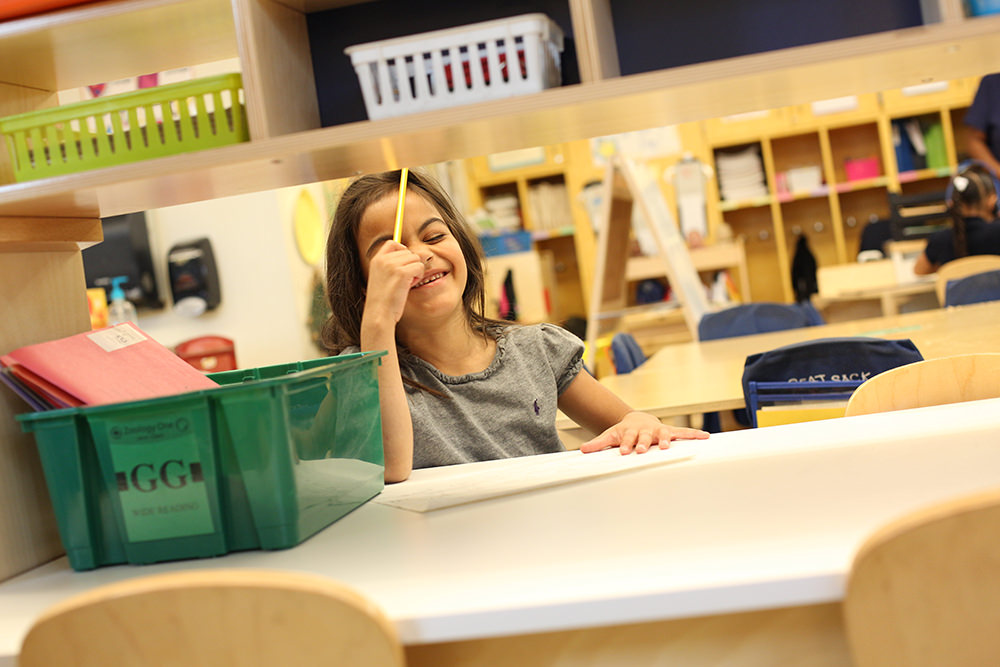
Independence
- Writers get right to work and continue writing for the entire work time.
- Writers know what resources they can use in the room to support their independence.
- Writers make connections to other areas of the curriculum.
- Writers take care of their classmates by working quietly.
For example: “Writers, I’m noticing that sometimes you get stuck on how to spell a word when you’re writing. When this happens please remember to use our chart on spelling strategies. Remember to do your best, and keep on writing!”
Taking Risks
- Writers enjoy writing in new genres.
- Writers try out new spelling strategies.
- Writers work with new partners.
- Writers are willing to share their writing and reflect on peer feedback.
For example: “Writers, I’m noticing that many of you have discovered a favorite topic that you always choose to write about. I would like to challenge you today to select something new to write about. Remember, we will grow as writers when we challenge ourselves to write about different topics and in different genres.”
Investment
- Writers are eager and excited to start new units of study to learn about new genres.
- Writers are excited to end each unit of study with a publishing celebration.
- Writers write for long periods of time using the tools and strategies that were modeled for them during mini-lessons.
- Writers are using strategies taught to them to make sure their writing makes sense.
- Writers are using resources in the room independently.
For example: “Writers, I know that Writing Workshop is a favorite time in our classroom. I’m noticing that sometimes it takes us a few extra minutes to get ready to begin which is taking up our precious writing time. Today we are going to discuss our routine for preparing for Writing Workshop so that we can focus all of our time on writing.”
Physical Environment
In her book Invitations, Regie Routman expresses the importance of thinking through the physical aspects of your classroom environment.
“Along with learning expectations and the emotional climate, the physical layout and setup of the classroom support the teacher’s philosophy of learning and teaching. The way we organize our classrooms affects children’s views of themselves as readers and writers and has an impact on their attitudes toward school and learning.” -Regie Routman, Invitations
Below are the elements to consider when creating a literacy environment that supports children’s independence, problem solving, and collaboration:
Space
When thinking about your space, make sure you have a place for the whole class to gather for the mini-lesson and share, spaces to meet in small groups, and spaces for children to work independently and with partners.
Here are some things to consider:
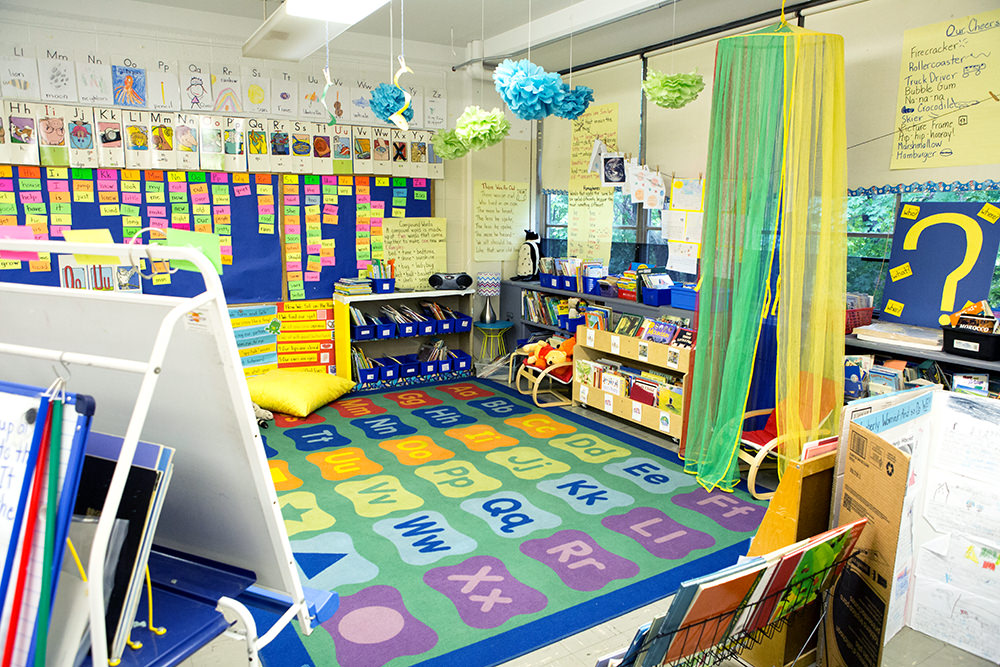
Whole Group Meeting Area
- The area should be large enough for all children to sit comfortably during the mini-lesson and share time.
- Make sure children can access anchor charts and other supportive print (word walls, word banks, etc.).
- Other materials you’ll need room for include:
- Chart stand and chart paper
- Comfortable teacher chair
- Shelves for storing teaching materials like dry erase markers, index cards, etc.
- Transition props such as a bell or chime (or other props like a pointer)
Small Group Meeting Area
- This areas should be big enough to meet with up to six children.
- Keep this space organized, with teaching materials easily accessible.
- Make sure your assessment binder, notebook, or notes are available.
- Make sure children can see relevant anchor charts or other supportive print.
- Other materials you might want available include:
- Writing and drawing utensils
- Paper choices
- Sticky notes
- Correction fluid or “boo boo” tape
- Dry erase boards and markers
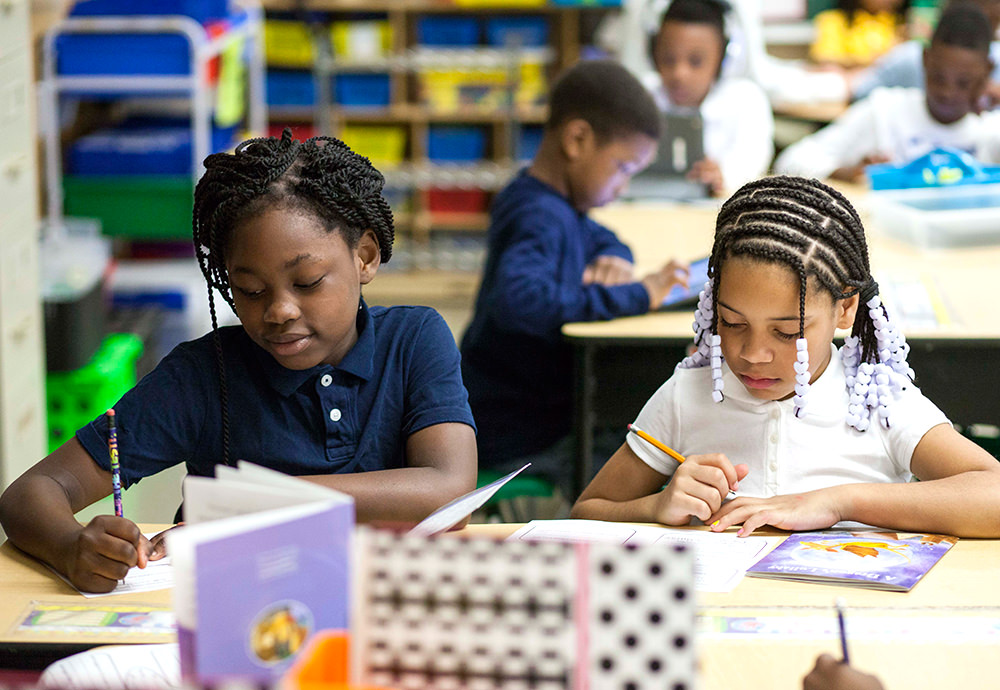
Areas for Children to Work Together
- Create spaces that encourage partners to cooperate and collaborate.
- Children could meet together on the rug or at a table.
- There does not need to be a designated spot for children to go when collaborating. Any area in the room where they can meet together with their writing supplies will do.
Areas for Children to Work Independently
- Create quiet, cozy, and inviting spaces for individual writing.
- Think about ways to spread children out throughout the classroom that encourage cooperation and collaboration during partner work.
- Make sure you have a clear view of all the children at all times.
Supportive Print
A print-rich environment can help your children grow as writers. Use the print in your classroom to support children to use the skills and strategies you are teaching and support their spelling and writing fluency. Anchor charts, word walls, word banks, and labels are all useful tools for your children.
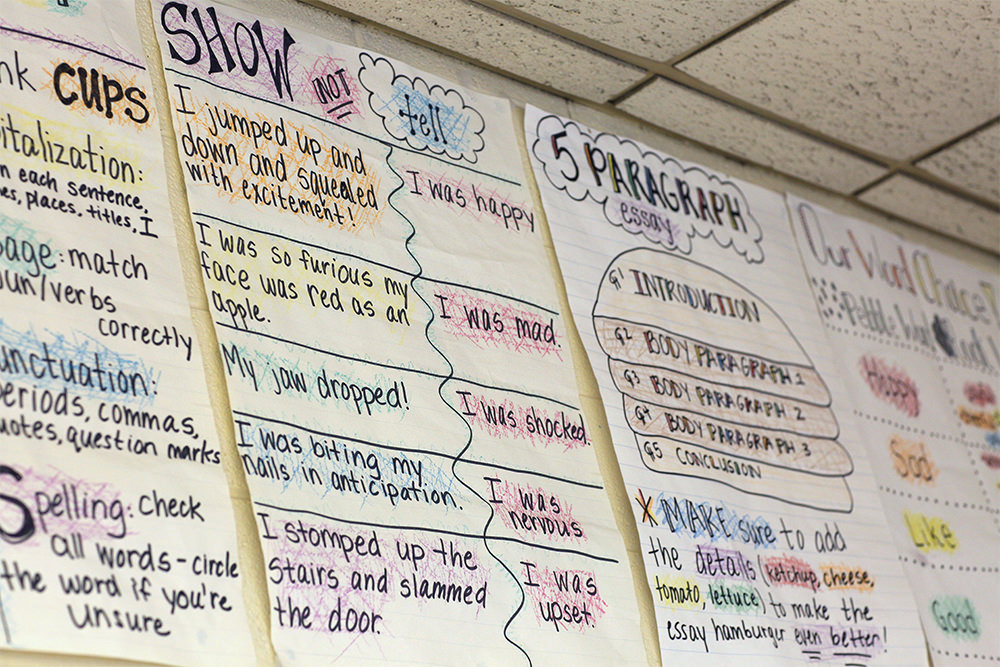
Anchor Charts

Anchor charts are child and teacher generated print that are used as reference tools. The charts are created with and by the children as you are teaching, and as the children are discovering new skills. Anchor charts are connected to your instruction and should be retired when they are not relevant, or not needed by your children anymore. Emergent readers and writers and English language learners will benefit from anchor charts with picture support.
In Writing Workshop anchor charts serve two different purposes. Some charts support children with writing procedures, and some charts support children with writing content.
Anchor Charts on Procedures
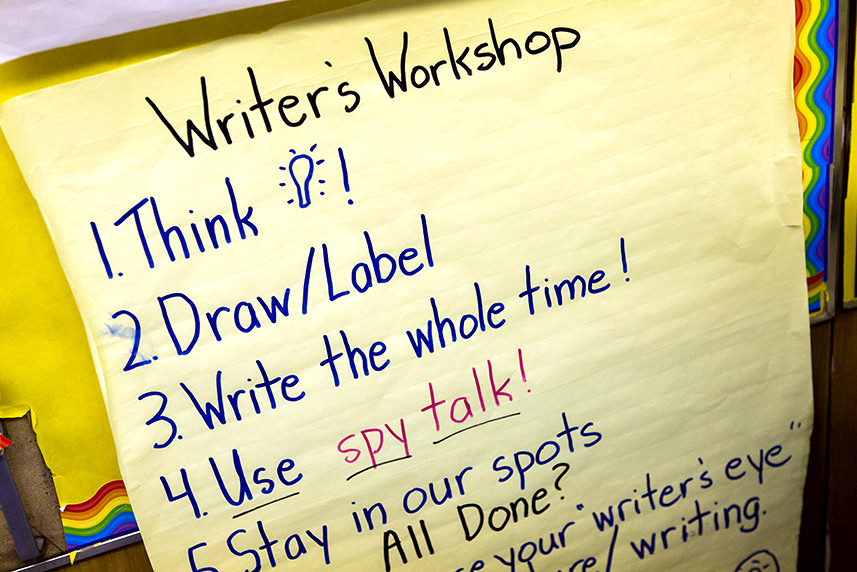
These charts are designed to move children towards independence. Examples of these charts include:
- How to turn and talk on the rug
- What to do when you’re done
- What to do if you need materials
- How to give feedback to your writing partner
- How to peer edit
- What to do if you’re stuck
Anchor Charts on Content
These charts will be specific to your writing instruction. Examples of these charts may include:
- Steps in the writing process
- Editing strategies
- Spelling strategies
- How to choose a topic
- How to write a strong lead
- Characteristics of different genres of writing
Word Banks
Word banks are lists of words relevant to your class.
Create word banks of words children often use in their writing. Choose word banks based on what you see children writing about and make sure to get their input about what to include in the bank. Popular word banks include:
- Family words (make sure to ask children what words they use for family members so that grandma, nana, meemaw and abuela are all represented)
- Animals
- Colors
- Foods
- Place names (school, church, home, playground, museum)
Create word banks to help children use new vocabulary and explore word choice. Some examples of these word banks include:
- Words to describe how someone might talk (whisper, bellow, say, yell, mutter, screech, etc.)
- Words to describe how a character might move (walk, trot, strut, march, run, gallop, careen, etc.)
- Words to replace “look” (gape, gawk, glare, stare, eye, leer, etc.)
- Words to describe a setting (serene, eerie, bustling, charming, quaint, deserted, etc.)
Create word banks that reflect the life of the classroom. These could be topics you are learning about in thematic units or in math, science, social studies, music, and art.
Word Walls
Word walls give children independence in spelling commonly used words. This will be a wall in your classroom devoted to high frequency words. Ideally your word wall will be at eye level for your children and will grow throughout the year as you add words each week.
The Writing Center

The writing center is a place to store all of the writing supplies that your children will need during their work time. It does not necessarily need to be a place where children go to get their work done; rather it is a place for children to go to get their supplies and store their writing folders and notebooks.
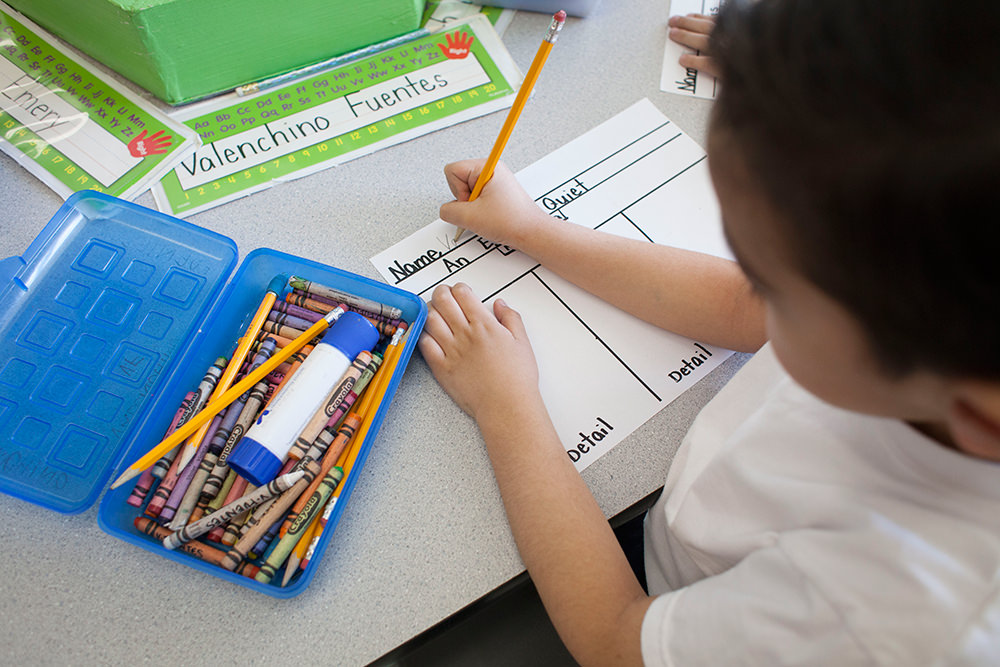
Ideas for supplies to be kept in the writing center include:
- Pencils
- Colored pencils, crayons
- Editing pencils
- Extra paper and different choices for paper
- Scissors
- Tape
- Word wall rings (words that are on the word wall organized on a ring for individual use)
Materials and Supplies
Materials and supplies are important supports for developing writers. The good news is that there is very little you need to get started with writing. The only necessities are paper and a writing utensil. With that said, the right materials can really go far to support your instruction and children’s development and growth. When we teach children how to manage their own materials and work, we are showing them that they are capable of managing themselves. We are promoting independence and choice. Introduce materials in mini-lessons so children understand how they are to be used, where to get them, and how to put them back.
Here are some of the materials you’ll want to consider for your classroom:
Folders
Writing folders with pockets are used to manage children’s papers in K-2 classrooms.
- Folders can be stored in a central location, like a shelf or writing center, or children can keep their notebooks in their desks or seat pockets.
- Keep all of children’s recent work in the folder (work from your current writing unit). At the end of the unit, work with children to empty out the folder. You can send some work home and keep some papers for your assessment binder or a child’s writing portfolio.
- Make sure that the children’s work is dated, so that you can follow progress.
- To help children organize work in the folder, put a red dot on the left pocket for finished (“stopped”) work. Put a green dot on the right-side pocket for pieces in progress (“go”).
- Supports for children could be placed inside the folders. Some ideas include:
- Copies of anchor charts with spelling strategies
- Word banks of words children will want to use (family words, colors, sight words)
- Alphabet or other phonic support
Notebooks
Third graders benefit from writing notebooks. Writing notebooks are a place for them to gather ideas, and plan. Children can use their writing notebooks to jot down and collect stories, anecdotes, quotes, topics, observations, etc. Notebooks encourage children to engage in the writing process. Teach notebook users to switch to lined paper when they are drafting. This will make revising and editing easier than if their drafts are written in a notebook.
Paper Choices
The type of paper a child uses affects the type of writing they do. Developing writers need a variety of paper choices. Paper conveys expectations. Determine what a child can do, and offer pages that give the right amount of challenge and support. For example, in the beginning of first grade, many children will work on paper that has a large picture box and only a few lines to write text. By the end of first grade, the paper may have just a small picture box and many lines of text.
- Offer paper choices that encourage children to write in all different forms: books, letters, recipes, poems
- Introduce one or two types of paper at the beginning of the year, and add more choices as the year goes on
- Provide booklets of pages stapled together to help beginning writers organize their thoughts and stretch their story or topic across many different pages.
- Teach children how to get more paper on their own and manage the papers in their folders
Utensils and Supplies
You’ll want to have a variety of writing utensils and supplies available to your writers. Some things to consider include:
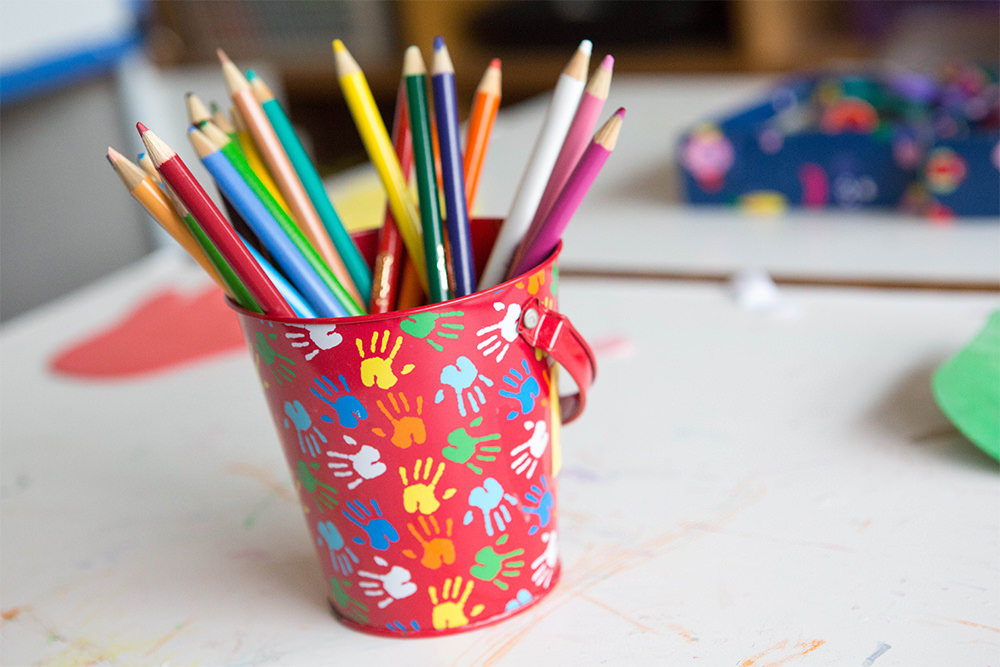
- Different types of pencils and pens
- Various colors and sizes of construction paper
- Scratch paper
- Note pads
- List pads
- Stationery
- Stapler and stapler remover
- White cover-up tape
- Markers
- Crayons
- Envelopes
- Date stamp
- Paper clips
- Scissors
- Rulers

Comments (27)
Log in to post a comment.